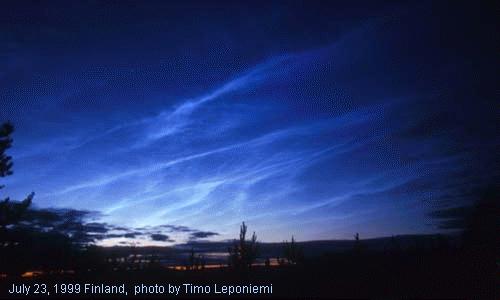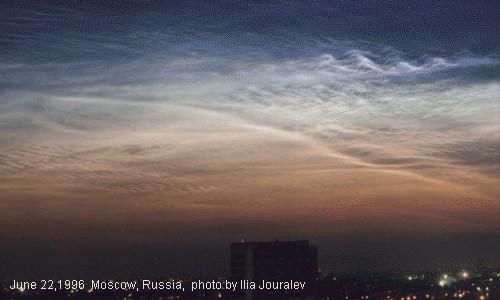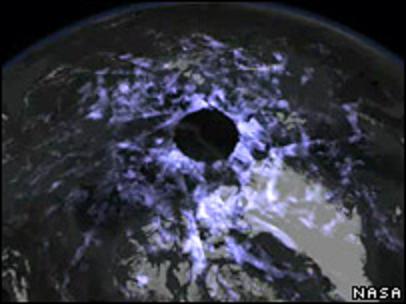Noctilucent Clouds


Noctilucent Clouds (NLC) occur at extremely high altitude, about 50 miles (80 to 85 km), and glow at night. They form in the cold (below -200 F), summer polar mesopause and are believed to be microscopic ice crystals.
| Type I | Veil: very tenuous, lacking in structure |
| Type II | Bands: long streaks, parallel or crossing at small angles |
| Type III | Waves: closely spaced herring-bone structure resembling sand ripples on a beach |
| Type IV | Whirls: large-scale looped or twisted structures |
The twilight conditions which render NLC visible, impose a latitude restriction on their visibility. They are, therefore, most often seen from locations which lie between Latitude 50 and 60 degrees in both hemispheres (though they are occasionally reported beyond this latitude band). Through most of June and July (from the northern hemisphere) these locations never attain true darkness and twilight skies persist all night. The latitude range takes in Canada, Northern Europe and Russia. Very few populated land masses exist at the corresponding latitudes in the southern hemisphere. Noctilucent clouds appear to be an extension of a more or less persistent feature of the summer polar mesosphere which is not visible to the naked eye at higher latitudes due to daylight conditions. These clouds, observed by instruments aboard satellites, are referred to as polar mesospheric clouds (PMC's).

A few useful internet resources:
NLC Observer's Homepage
Australian Antarctic Division NLC page
Pekka Parviainen's Polar Image site.
Science@NASA:
*Strange Clouds
*Climatology and Climate Change
*Teleconnections
Aeronomy of Ice in the Mesosphere (AIM) home page, A current satellite mission launched in 2007
AIM mission song and
YouTube video with lyrics
Some nice videos on YouTube:
Denmark (11:25 pm - 4:00 am, July 11/12, 2011; latitude 56.2 degrees North)
Russia (after sunset)
British Columbia (before sunrise)
Norway (after sunset with regular clouds below)
Scotland (with aurora beginning around the middle of the clip)
Northern Europe from International Space Station
HISTORY OF NLC Observations and Theories
| June 8, 1885 | First reported observation (Bad Kissingen, Germany); possible earlier accounts |
| summer 1885 | Several other reports across northern Europe and Russia |
| late 1880's | Connection with volcanic dust proposed |
| late 1880's | First photos by Otto Jesse |
| 1906 | Foerster proposes clouds are made of cosmic dust |
| 1912 | Wegener proposes clouds are made of water ice |
| 1926 | Malzev disproves volcanic dust hypothesis |
| 1933 | Humphreys proposes ice or ice-covered cosmic dust |
| July 20, 1933 | First North American photos (Meanook, Alberta) |
| 1957 | Systematic European observations begin |
| 1961 | Hesstvedt provides quantitative theory for ice |
| 1962 | Systematic North American observations begin |
| 1962 | First rocket launch into a noctilucent cloud |
| mid 1960's | Observed in Southern Hemisphere |
| 1960's | Measurements of mesospheric temperatures and water vapor lend support to ice hypothesis |
| 1969 | Witt proposes formation on ions |
| 1972 | Orbiting Geophysical Observatory (OGO-6) satellite detects persistent summer daytime clouds over poles |
| 1981 | Solar Mesospheric Explorer (SME) satellite confirms summer polar mesospheric cloud layer |
| 1989 | Future increases in frequency/brightness of clouds predicted |
| 2001 | HALOE (Halogen Occultation Experiment) confirms primary component of PMC's is water ice |
| 2012 | AIM detects "meteor smoke" in NLC's |